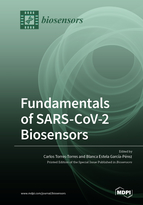Fundamentals of SARS-CoV-2 Biosensors
A special issue of Biosensors (ISSN 2079-6374). This special issue belongs to the section "Biosensors and Healthcare".
Deadline for manuscript submissions: closed (31 July 2022) | Viewed by 44826
Special Issue Editors
Interests: photonics; nonlinear optics; interferometry; spectroscopy; biosensors; instrumentation of biosignals; biophotonics; nanotechnology; machine learning; artificial intelligence
Interests: biosensors; biosignals; confocal microscopy; plasmonics; fluorescence; nanosciences; microbiology; virology; immunology; authophagy
Special Issue Information
Dear Colleagues,
This Special Issue, entitled “Fundamentals of SARS-CoV-2 biosensors”, has been devoted to one of the more dynamic battlefields for sensor technology in our era. Biosensors have been driven for the widespread diagnosis and treatment of COVID-19. Coronavirus identification by chemical and physical biosignals represents an urgent topic of scientific research, with explosive progress for screening and evaluating its potential action in biological parameters. Biosensors are between the most evocative members of the family of the modern world of technology. Original or review papers describing new opportunities for revealing the activation or inhibition of coronavirus threatening biological systems are welcome.
Dr. Carlos Torres-Torres
Dr. Blanca Estela García-Pérez
Guest Editors
Manuscript Submission Information
Manuscripts should be submitted online at www.mdpi.com by registering and logging in to this website. Once you are registered, click here to go to the submission form. Manuscripts can be submitted until the deadline. All submissions that pass pre-check are peer-reviewed. Accepted papers will be published continuously in the journal (as soon as accepted) and will be listed together on the special issue website. Research articles, review articles as well as short communications are invited. For planned papers, a title and short abstract (about 100 words) can be sent to the Editorial Office for announcement on this website.
Submitted manuscripts should not have been published previously, nor be under consideration for publication elsewhere (except conference proceedings papers). All manuscripts are thoroughly refereed through a single-blind peer-review process. A guide for authors and other relevant information for submission of manuscripts is available on the Instructions for Authors page. Biosensors is an international peer-reviewed open access monthly journal published by MDPI.
Please visit the Instructions for Authors page before submitting a manuscript. The Article Processing Charge (APC) for publication in this open access journal is 2700 CHF (Swiss Francs). Submitted papers should be well formatted and use good English. Authors may use MDPI's English editing service prior to publication or during author revisions.
Keywords
- COVID-19 detection
- SARS-COV-2
- biosensors
- biosignals
- nanotechnology
- instrumentation systems
- signal processing
- optics
- virology
- immunology







